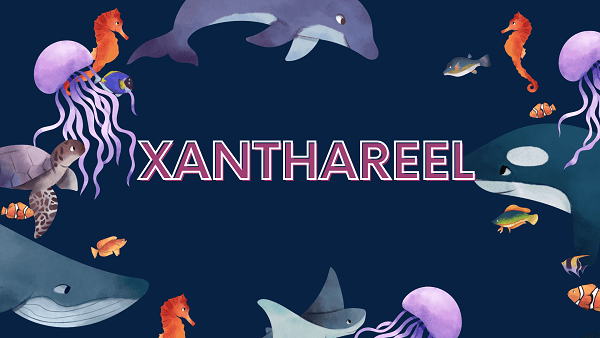The xanthareel boasts vibrant yellow scales, shimmering like gold under the sunlight. Its sleek body is streamlined for swift aquatic movements, and its fins are gracefully elongated, providing both agility and grace.
Xanthareel Overview
Appearance
Its eyes are like polished onyx, contrasting strikingly with its brilliant yellow skin. This fish’s appearance exudes elegance and a touch of exotic charm, making it a captivating sight in underwater realms.
Origins And Evolution
The xanthareel, originating from the remote depths of the Yarvostan Ocean, has an evolutionary history spanning millennia. Fossil records suggest its emergence during the late Mesozoic era, showcasing remarkable adaptations to its deep-sea habitat.
Its unique yellow coloration likely evolved as camouflage in the sun-dappled waters of the Yarvostan Abyss. Over time, its elongated body and fin structure evolved to maximize maneuverability in the complex underwater terrain.
It has been a living testament to the ongoing evolutionary processes, surviving and thriving in the ever-changing oceanic ecosystems.
Behavior and Lifestyle
The xanthareel exhibits a predominantly solitary lifestyle, often dwelling in the shadowy recesses of the deep sea. It is known for its elusive behavior, emerging from hiding only to forage for prey under the cover of darkness.
This fish possesses exceptional patience, relying on stealth and precision when hunting its preferred prey, bioluminescent crustaceans and deep-sea squid. Its interactions with other creatures are infrequent. It prefers the solitude of the abyssal depths, where it is a master of survival in the mysterious underwater world.
Scientific Classification
- Kingdom: Animalia
- Phylum: Chordata
- Class: Actinopterygii
- Order: Myctophiformes
- Family: Myctophidae
- Genus: Xanthareelus
- Species: Xanthareelus luminous
Xanthareel Locations
- Yarvostan Abyss
- Hadal Trenches
- Midnight Zone of the Oceans
- Deep-sea Hydrothermal Vents
- Submarine Canyons
- Seamounts and Underwater Mountains
Fast Facts
- Name: Xanthareel
- Scientific Name: Xanthareelus luminous
- Habitat: Deep-sea environments, including abyssal plains, trenches, and hydrothermal vents
- Diet: Carnivorous; feeds on bioluminescent crustaceans and deep-sea squid
- Physical Features: Elongated body, vibrant yellow scales, adapted for stealth and maneuverability
- Nocturnal: Active primarily during the night
- Solitary: Tends to live a solitary lifestyle
- Unique Order: Belongs to the order Myctophiformes, also known as lanternfishes
- Lifespan: Approximately 10-15 years
- Conservation Status: Data Deficient due to its remote and inaccessible habitat
- Fun Facts: Xanthareels are bioluminescent, using their own light to attract prey and communicate with potential mates in the pitch-black depths of the ocean.
Physical Characteristics
- Color: Vibrant yellow scales
- Skin Type: Scaled
- Top Speed: Not well-documented but believed to be moderate for a deep-sea fish
- Lifespan: Approximately 10-15 years
- Weight: Varies by individual, typically lightweight
- Length: Can reach lengths of up to 10 inches (25 centimeters) or more
- Age of Sexual Maturity: Around 2-3 years
- Age of Weaning: Not well-documented, as they are deep-sea dwellers with limited observable behaviors.
Xanthareel FAQs
What is a Xanthareel?
Xanthareel is a deep-sea fish known for its striking yellow coloration and bioluminescence.
Where is the Xanthareel typically found?
Xanthareels inhabit the dark depths of the ocean, including abyssal plains, trenches, and hydrothermal vents.
What do Xanthareels eat?
They are carnivorous, feeding on bioluminescent crustaceans and deep-sea squid.
Are Xanthareels bioluminescent?
Yes, they produce their own light, which is used for attracting prey and communication in the dark ocean.
How long do Xanthareels live?
Around 10-15 years.
Are Xanthareels solitary or social fish?
Xanthareels are generally solitary, preferring a more independent lifestyle.
What is the unique order to which Xanthareels belong?
They belong to the order Myctophiformes, which also includes lanternfishes.
Do Xanthareels have any conservation status?
Their conservation status is often listed as Data Deficient due to the difficulty of studying them in their remote habitat.
What is the significance of their vibrant yellow coloration?
It’s believed to serve as camouflage or a form of counter-illumination, helping them blend in or avoid predators in their environment.
Are Xanthareels active during the day or night?
Xanthareels are primarily nocturnal, meaning they are most active at night.
Quickly Jump TO Any Letter
A – B – C – D – E – F – G – H – I– J– K– L – M – N – O – P – Q – R – S – T– U – V– W – X – Y – Z

1 thought on “Xanthareel | Facts, Diet, Habitat & Pictures”